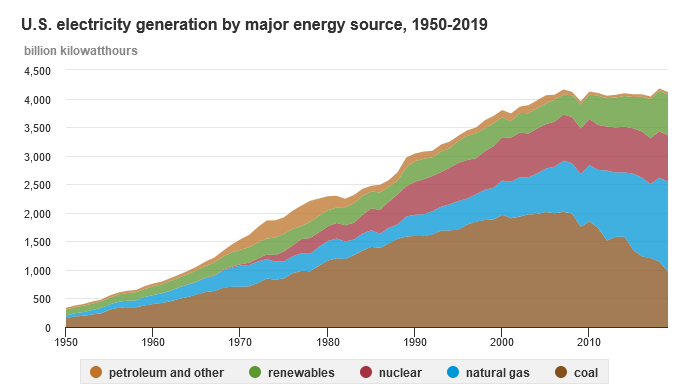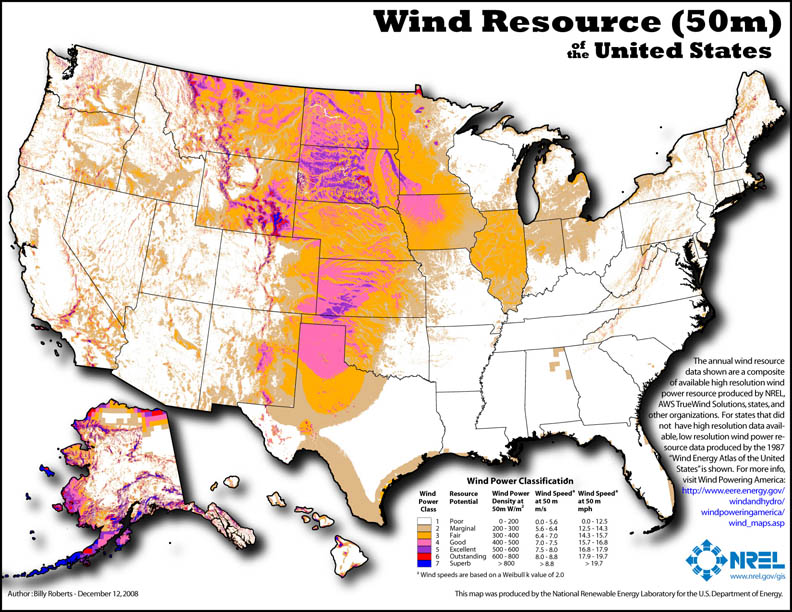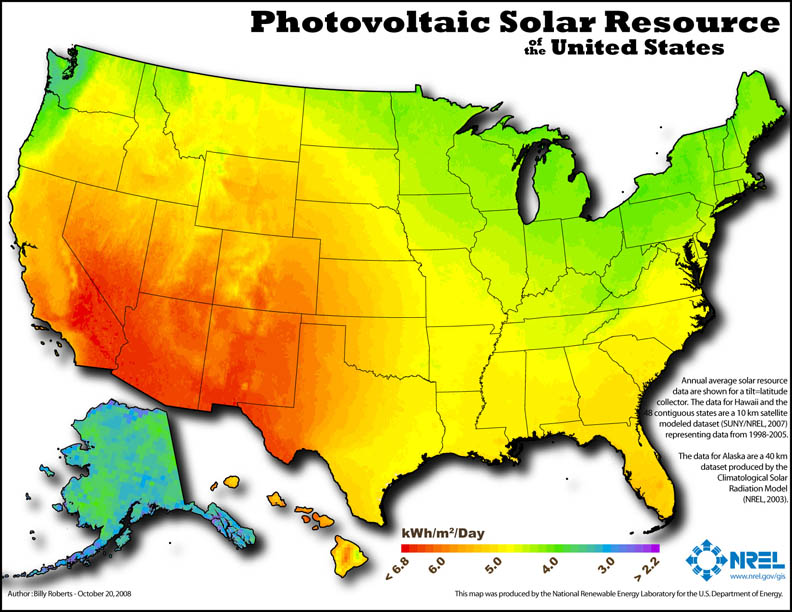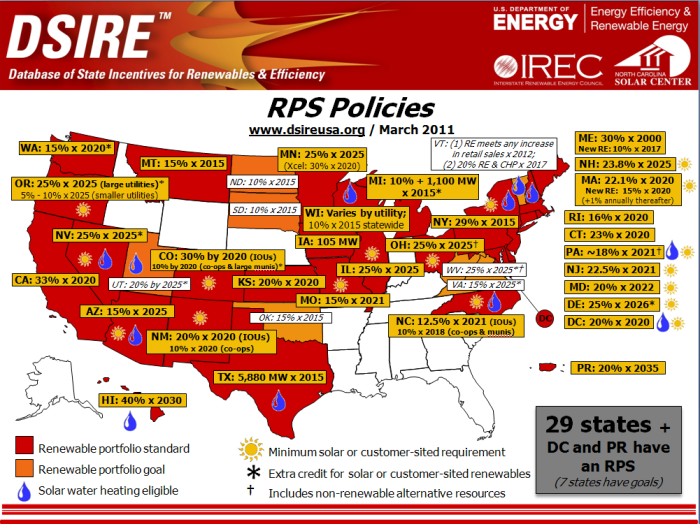Reading Assignment
Please read this EIA page on renewable energy.
We can see from the pie chart in the previous section of this lesson that renewable energy supplies a small fraction of electricity in the United States. However, it would be very beneficial for us to increase the share of generation coming from renewables. The primary motivation is to reduce the amount of power generated by burning coal, which has a large number of negative side-effects as described in the previous section.

There are a few points that can be made from examining this graph.
- Despite peaking in 2007, coal has declined to about 24% in 2019.
- Natural gas share has grown by nearly 90% since the start of the shale gas boom in 2005, and has surpassed coal as the most popular generation fuel, 38% in 2019.
- Nuclear energy has been quite stable, as no new plants have been built since the 1980s (20% in 2019).
- The amount of energy generated by hydroelectric facilities is trending downwards as we remove more and more dams and return more rivers to their natural state.
- Petroleum use for power generation is rapidly trending towards zero as the price of crude oil climbs.
- After being flat for many years, renewable energy has grown considerably recently. Average annual growth over the past decade has been over 12%.
However, because it was starting from a very low point, even this impressive growth still means that renewables are responsible for 18% of all electricity generated in the US in 2019.
When we speak of renewable generation, we are speaking of the following things:
- Biomass, such as wood, wood waste, agricultural products, and black liquor from paper making;
- Biogenic municipal waste or, in other words, organic trash;
- Geothermal energy;
- Tidal and wave energy;
- Landfill gas, captured from the decay of garbage in dumps;
- Solar energy;
- Wind.
While hydro is a renewable energy, it is generally considered to be in a separate class. The vast majority of renewables installed in the US over the past five years are in the form of wind power. The great appeal of wind and solar power is that the marginal cost of operating these facilities is close to zero - the fuel is free and non-polluting.
So, why are we not having more of these forms of generation built, if it is basically "free energy"? There are three basic problems:
- Capital costs are very high.
- Resources are located far from people.
- Resources are not controllable.
Capital Costs
There is an abundance of wind and solar energy in our environment. Several academics have done studies and have discovered that the amount of solar energy hitting the planet is many, many times greater than the amount of electricity we consume. The same is true for the energy contained in the wind - it contains perhaps 50 times as much energy as the world consumes in electricity. The problem with all of this energy is that it is at a very low concentration - it is broadly spread out. The greatest benefits of uranium, oil, and coal are that they have a very high energy density - they pack a lot of punch from a small package. This makes them convenient to use - I can spend 10 minutes putting 20 gallons of diesel in my car and then be able to operate the car for 10 hours or more without refueling.
Wind and solar are very diffuse. To be concentrated up to levels that are useful for people to use, a lot of equipment taking up a lot of space is required. A nuclear power plant that generates 2,500 MW of power might sit on 1,000 acres, but to get the same power from windmills, we would need to put up about 1,000 separate windmills, each on occupying 40 acres of land, for a total of 40,000 acres. If I put 1,000 square feet of solar panels on my roof, it would generate about 10 kW, or about 1/25th the power generated by my car. So, for renewables to work on the sort of scale we need, we need to build a lot of them - many windmills or many solar panels.
The table below lists the approximate costs of constructing different types of power plant. These data were generated by the EIAS, and can be found at this link.
| Plant type | \$/kW |
|---|---|
| Coal-burning steam turbine | 3,500 |
| Gas-burning jet engine | 1,000 |
| Gas-burning combined cycle | 1,000 |
| Nuclear-powered steam turbine | 6,000 |
| Onshore wind turbine | 1,900 |
| Solar (photovoltaic panel) | 2,600 |
The costs above are given in units of dollars per kilowatt of capacity to generate electricity, meaning that all different sources can be compared on the same scale. As you can see, wind turbines cost more than gas-fired plants, and solar plants cost somewhere between gas-fired and nuclear plants. It should be pointed out that solar energy has seen declining capital costs over the past few years, as the cost of manufacturing solar photovoltaic cells have fallen significantly recently. In 2008, solar cost more than nuclear plants on a per kW basis. You may have read about the "Solyndra Scandal", whereby a US solar equipment manufacturer recently declared bankruptcy after receiving several hundred millions of dollars in federal subsidies. The bankruptcy of Solyndra was caused directly by the falling price of solar panels.
The aforementioned capital costs make it difficult for investors to earn a good return on such facilities. By selling power at normal market rates, these plants typically do not pay for themselves for many years. Thinking back to the opportunity cost concept, there is probably another place where a person can invest money that will give a better return. If you can invest money elsewhere and make more money with less risk, why would you build renewable power plants?
Resource Location
In the United States, large numbers of people tend to be gathered near the coasts, be they the Atlantic, Pacific, Great Lakes, or Gulf of Mexico. Unfortunately, this is not where most of the wind and solar are. The following two maps show the locations of the most reliable wind power and the most solar energy available. These maps were obtained from the website of the National Renewable Energy Laboratory, which is located in Golden, Colorado.


As can be seen, most of the best wind is in the Great Plains: the Dakotas, Iowa, Wyoming, Kansas, and Texas. For the most part, these are thinly populated places, far from most big cities. In fact, the only large cities that obtain a large share of their power from wind are Dallas/Fort Worth, Austin, and San Antonio, in Texas. Solar potential is largely concentrated in the southwest desert states and southern California. While there are certainly many people in California, it has proved difficult to build solar plants there, due to stringent environmental regulations.
If we wish to build lots of wind and solar in these thinly-populated places, we will have to build lots of transmission to move this power to population centers, and this is also a very expensive, bureaucratic, and politically difficult proposition. Just getting a few lines built in Texas has taken several years, with lots of wrangling over who pays for the transmission. Some people would like to see the cost of this transmission broadly socialized over as broad a population base as possible, whereas others would like the costs to be borne by people who stand to benefit directly, but it has proved difficult to figure out who benefits by how much, and then how to incentivize such people to purchase transmission strictly for renewable generation, especially when fossil-fuel generation is closer and does not need new transmission. This is a public goods problem.
Resource Reliability
One of the things we want from an electric system is controllability because this gives us reliability. When I turn on my TV, I expect there to be power for it, and when I do, the power company has to be ready to respond to generate that power to deliver to my house to serve my load. The same is true of everybody else. For this reason, electricity system operators need to be able to turn plants on and off as required by load. This is what is referred to in the industry as "dispatch". The problem with wind and solar is that they are not dispatchable - they cannot be turned on and off at will by power system operators. The wind blows when it blows, and clouds block the sun, and there is precious little that we can do about it. For this reason, we cannot have a system with too many renewables, because they cannot be reliably controlled, and if there are too many in a system, then the reliability of that system is difficult to maintain. And, as I said above, we value reliability in an electricity system above everything else.
The more renewables in an electricity system, the more fast-starting gas-fired backup generators are required. Once again, the issue arises: who gets to pay for these?
Another complicating factor: the wind tends to blow the most early in the morning hours, and mostly in the spring and fall. These happen to be times when the demand for electricity is at its lowest. If you can think of the super-hot dog days of summer, you realize that one of the defining characteristics is that the air is very still - no breezes to move the air around and cool us off. Thus, the wind is not there when we need it most and is there when we need it least. If we want to utilize the wind in a more reliable manner, we need to couple the wind with energy storage, which is another subject entirely, and a rather expensive one. At least, solar has the benefit of being present at times when we most need the power.
Incentivizing Renewable Energy
So, we like renewables because they are clean, domestically sourced, and have a very low marginal cost. But they are very expensive from a capital cost perspective, because we need a lot of equipment to concentrate the diffuse atmospheric energy up to a useful density, because we need to build expensive transmission lines from the remote sites of renewable generation to population centers, and because we need to build expensive backup generation or even more expensive energy storage to maintain the reliability we have grown accustomed to.
It's a wonder that any ever gets built! So, why is so much being built? Why is it growing at about 20% per year? Because of incentive programs. 29 states, plus the District of Columbia and Puerto Rico have incentives for the building of renewable generation. These programs are summarized on the following slide, from the Department of Energy's Database of State Incentives.

Recommended Reading
You can find much, much more detail of all of these programs at the DSIRE website.
The above slide displays states that have what is called a "renewable portfolio standard". What does this mean? It means that a certain portion of the power sold to end users in a state must come from renewable sources. This is how it works:
- A state government passes a rule saying that, for example, 25% of all electricity sold by a utility to end users must be from renewable sources.
- The government creates a device called a "renewable energy certificate", abbreviated "REC".
- When a company generates power from renewable sources, it is given a REC.
- When the company sells this power to a utility, it also sells the REC with the power - the utility has to buy the REC.
- The utility has to give the government a sum of RECs that is equivalent to 25% of the power they have sold. If they do not have enough RECs they have to pay a penalty, called an "alternate compliance payment (ACP)".
So, you can see the economics at work. Let's say that a utility has to pay \$600 per MWh in ACP for each REC they do not have, but which they need. Therefore, the utility is willing to pay up to \$600 for each MWh of RECs. So, the owner of renewable generation is given a REC by the government for each MWh of power he generates, and he is then able to sell it for some price that might be as high as \$600.
Now, an example: let's say I have spent about \$5,000 to install a 2 kW solar system on my roof. Where I live, in New Jersey, solar panels have an average capacity factor of about 14.5%, so my 2 kW system generates . Let's say I sell this electricity for the going rate - \$50 per MWh. So, I make \$125/year selling electricity. This is a pretty bad investment - I have spent \$5,000 to earn \$125 per year, or a return of about 2.5%.
But with a REC, instead of just earning the \$125 for selling electricity, I also get to sell 1.4 RECs for, say, \$550 each. Now I earn per year on my \$5,000 investment. That's a 18% rate of return - pretty good.
It also helps that the Federal Government gives me a tax credit that is worth 30% of the cost of the system, or \$1,500. So, in reality, I only paid \$3,500 after tax, and I am earning \$895 per year, for a return of 26%. which is a very good investment at any time. You can understand why I am looking at putting solar panels on my house!
The REC system has an appealing feature, in that as we get more renewables, there will be more RECs generated, and we know that as something becomes more available, the cost tends to drop - the supply curve is moving to the right. So, the more renewables, the lower the value of RECs, and the lower the incentive to build more renewables than the program is targeting.
Recommended Reading
For another overview of how RECs work, please see this site put together by the Union of Concerned Scientists.
